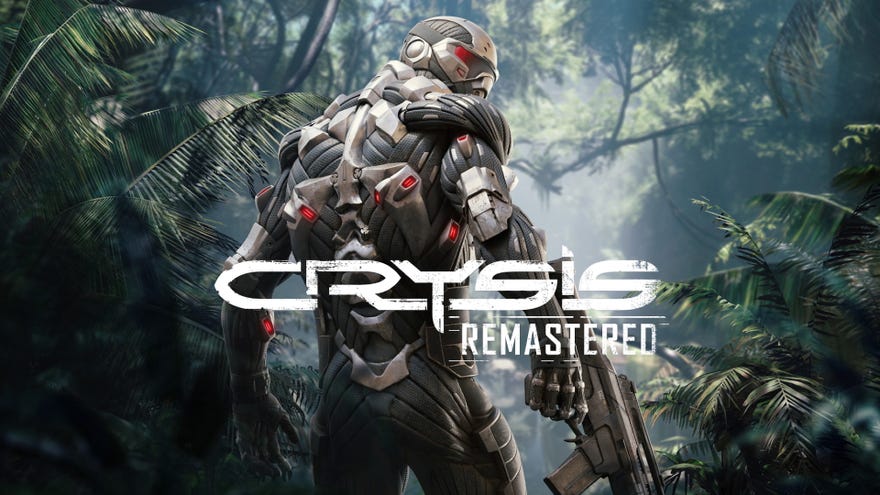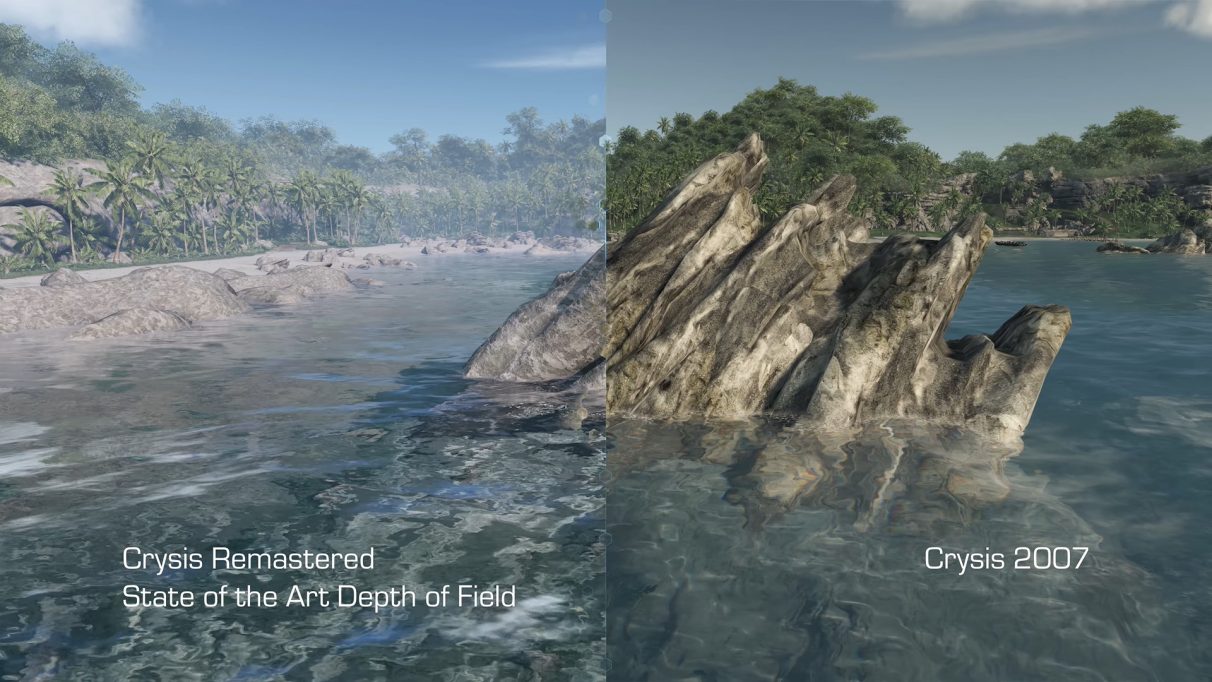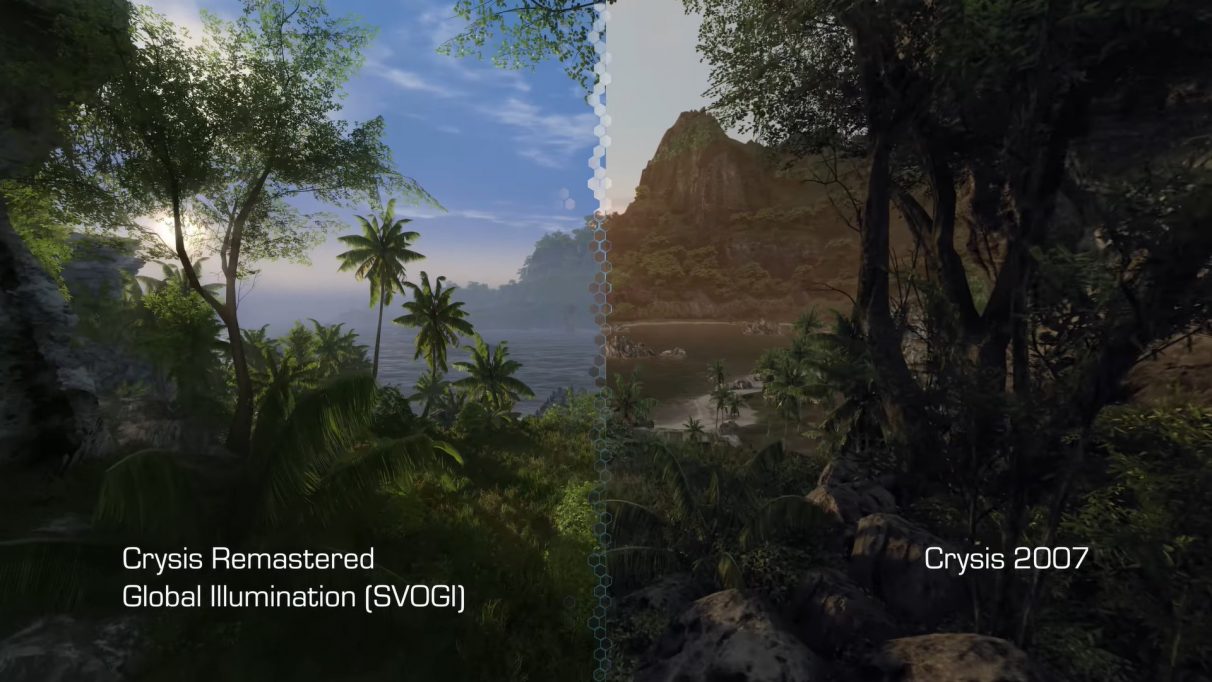Crysis Remastered's lead dev talks ray tracing, and why it's OK if you can't play 'Can It Run Crysis?' mode
Really, it's fine
Famed for its steep requirements and melting PCs the world over, the original Crysis was arguably one of the most important PC games of its day when it first came out in 2007. Not only did it push current PCs to their limits, but it also became a touchstone for the avid benchmarkers in the years that followed. Whenever you built a new PC, the joke was always, "But can it run Crysis?"
Now, that joke is probably going to become, "But can it run Crysis Remastered?", which arrives on the Epic Games Store tomorrow, September 18th. With support for 8K textures, software-driven ray tracing, real-time reflections and loads more, developer Crytek and partner Saber Interactive have given the 2007 original quite the new coat of graphical paint - and I got to speak with Crysis Remastered's project lead Steffen Halbig ahead of the game's launch to talk all about it. We chat about everything from what kind of performance you can expect from its official PC requirements, to how their software-based ray tracing works, and why there's currently no system on the planet that can max out its aptly-named "Can It Run Crysis?" mode.
RPS: It's safe to say that the original Crysis was one of the most technologically advanced games of its day. At the time, did you ever expect that it would continue to give PCs such trouble for as long as it did?
Steffan Halbig: Yes, we were aware of this because we had these high-end graphics cards back in the day, I think it was the 8800 Ultra from Nvidia around this time, and of course we got some nice engineering samples to test Crysis with, and we were aware that it wasn't running very well on these high-end graphics cards. I think the highest resolution back at the time was Full HD, and it was nearly impossible to run the game. In Full HD, you were getting 10fps or 5fps, so we were sure in the future that these graphics cards would have trouble running the game in higher frame rates. So we did expect it back then, but at the end, it was also good for us, as it started the meme, 'Can it run Crysis?'
RPS: When you're pushing the boundaries like this, how much of a conversation is there between you and hardware manufacturers to be able to accommodate the kind of advances you're making? Do you know the hardware is coming, or do you just kind of 'hope' it will come eventually?
SH: So, of course we are in touch with the graphics card manufacturers like AMD and Nvidia, that's for sure, that's normal. Also from a driver-side level, we need to make sure everything is running very smooth and very well. That's normal process in development.
Besides that, it's in Crytek's DNA that we're just pushing everything to the limits, so of course we're taking care of people with lower-end graphics cards with our options menu in Crysis Remastered. But for high-end graphics cards especially, we've got the 'Can It Run Crysis?' mode. Already in 4K, it will be hard. I'm not aware of the performance of the new graphics cards, but what I've seen so far from the internet, it will also be hard for these graphics cards to run 4K smoothly with the 'Can It Run Crysis?' mode.
RPS: Even though you've got a lot of next-gen features in Crysis Remastered, I think a lot of people were surprised by how manageable its PC requirements were when they got announced. It seems like you've tried to cater for a reasonably broad range of systems this time - was this a big focus for you?
SH: The PC requirements on the Epic Games Stores are only for Medium and High specs, and Low specs. So once you start to go into Very High and 'Can It Run Crysis?' mode, erm... no chance with these systems! On Epic, you can only fill out minimum and recommended requirements. There's no special field for high-end. We also talk about this internally, about how we can make the users more aware of all the kinds of specs, especially the different graphics modes, which we're working on at the moment.
For 'Can It Run Crysis?' mode, you really need an RTX 2080 Super or 2080 Ti, for example, that's for sure. 4K is not possible, but at lower resolutions these cards can run it. Also, with our software ray tracing solution, it's also big on CPU usage, so a good CPU is needed even in higher modes to have fluid performance.
RPS: Do you think it's important to still have those big 'must-have upgrade' games on PC?
SH: Absolutely. For us, PC gamers are still special for us. We take care of them. But I think it's important to push the industry with new titles and pushing games to the limits of technologies, and I think it's okay if the highest mode cannot run on, let's say, 'good' PCs, and you need a 'very good' PC for that. I think that's totally fine. If you have a scalable options menu and you can change it, that's fair. But if you want everything maxed out, then of course you need a very high-end PC. I think that's fine, especially for a title like Crysis.
RPS: Why bring Crysis back now? Is it because we finally have the hardware to fulfil that original vision?
SH: We've had thousands of messages over the last couple of years, and the community - it doesn't matter what we post, we can talk about the weather on our social media channels and people will say, 'what about Crysis Remastered?' So that was one of the major points for us, that people want to have it.
It was also because our Cry Engine developed further and further and we had more features included, so it was a combination of both. Then of course we found our great partners at Saber Interactive, and that was a great fit together with the software ray traced technology. So we talked about it, and then we started, I think it was 14-15 months ago now, and we've made it happen.
RPS: How long have you been looking at real-time ray tracing? It feels like Nvidia suddenly solved this big problem back when they launched the first RTX cards in 2018, and while Crysis Remastered will support hardware accelerated ray tracing for those graphics cards, you've also found a way to implement it via software thanks to your SVOGI tech.
SH: So we've had this technology a little bit longer, let's say, in our basement, but then we decided to work further on it and then we made the Neon Noir demo. So based on Neon Noir, we of course saw some limitations on what you can do with it, but we decided that we can do a lot more with it. Neon Noir is just a street, but then we decided to go into the full AAA open-world gameplay, and of course that's a completely different challenge. But yeah, we made it.
To jump back to the hardware ray tracing support, the most important part to getting a performance boost from hardware ray tracing. We're also working on maybe one or two little features that are exclusive to hardware ray tracing. You have the RT cores on the RTX cards, which gives you more performance, and because of that we can already show, for example, more characters in the reflections. Apart from that, this is the only real performance difference. The quality of the ray traced images will be the same between software and hardware ray tracing. There are no differences.
People are just getting more performance from RTX cards, that's it. At the moment, if you're in front of a car, glass, or looking through the water, for example, you see yourself. So Nomad, the nanosuit character, is reflected everywhere. That's for software and hardware ray tracing. But, for example, now for hardware, you also get [reflections of] soldiers running around you. That's something we want to give on top for hardware ray tracing because we can handle this performance with the RT cores.
RPS: If it's possible to ray tracing within software, why haven't more developers made use of it?
SH: I think it's a big challenge. If you're willing to invest time and money to work on something different... or you just say, right, the market is there, the solutions are there, the graphics card market is there, and you take it. So I think most of the time, people just do this, but again it's in our DNA to develop our own stuff and push it to the limit.
RPS: Lighting, shadows and reflections have obviously been big focus points for you with Crysis Remastered. Why was it important for you to update these?
SH: In Crysis, you have oceans and a lot of jungle environments, and I think it's very important that people are aware it doesn't matter where they want to go in the level. Walking around, you're always facing the updates in Crysis Remastered, and since Crysis is known for its open world gameplay, we thought it was important for the preview that people knew we'd taken care of all areas in the game.
RPS: How do you balance the performance costs of it being a fast-paced shooter?
SH: One of the biggest points is the resolution inside the reflections. For ray tracing options, we have 'Off', of course, we have Performance mode, we have a High mode, Very High and Can It Run Crysis?
For Can It Run Crysis mode, all the reflections are mostly 4K, so it looks very sharp, but of course, performance is not so good. But you can also go down to Performance mode, where the reflections are only in 720p, or 540p. It still looks great, but you're getting 50-60% more performance out of this just by changing the ray tracing settings. If you go very close to reflections, you can see a difference, but overall it still gives you a nice feeling. The options are very scalable, and people can choose what they want based on the power of their hardware.
RPS: Do you think realistic lighting is the biggest technological challenge that game developers face today?
SH: Back in the days, we had baked lights everywhere. Everything looked so bright. But now with global illumination and ray tracing, it feels real. You can see how the light is bouncing on the ground and into the walls, and it just adds a realistic touch. And you don't really need to do much about it apart from setting it up, because the technology is doing its own thing. You just need to design the level and the lights are already going into it in every direction, so I think it's easier now for developers compared to the past.
Ray tracing is still on the starting line, I think. I'm aware that AMD are also working on a hardware solution with their [ Big Navi ] graphics cards, and with the Nvidia Ampere cards, there's a big performance boost there. I think we'll see more games now with ray tracing added on top. I think it will all come together now to have more realistic lights, and ray tracing will get better and better over the coming years. At the moment, yes, I think ray tracing is still the biggest challenge right now.
RPS: What do you think PC players are most looking forward to in Crysis Remastered?
SH: People really want something that pushes the PC to the next level. We don't care about how much graphics memory you need. We don't care about how much performance you get from the 'Can It Run Crysis?' mode. We just max everything out in this mode, so I think that's very important, and that's what we've put a lot of love into. The textures are really high-res. If it's 8K, it's 8K. I think that's the answer on this. It's people recognising that we're pushing the PC to the limit, and they'll see the differences. In 'Can It Run Crysis?' mode, it has unlimited distance, everything is there, nothing will pop out anymore, and it's really cool.
RPS: Is there a system today that can run 'Can It Run Crysis?' mode?
SH: Which resolution are we talking about here? At 1080p, I think an RTX 2080 Super is fine, but at 1440p, you'll get some struggles, so I'd maybe recommend some newer graphics cards when they're out from Nvidia. At 4K, I don't see realistically one card that could run it.
For us, though, it's important that the 'Can It Run Crysis?' mode is a future-proof spec where people can always test their hardware. Crysis was known back in the day for this, and it was also covered very well over the last few years because of it, and we think with this 'Can It Run Crysis?' mode people will have a lot of fun, not with the new Ampere or new AMD generation of graphics cards, but maybe in two or three years when something newer comes out, we think people will try again to run 'Can It Run Crysis?' mode to see if it runs smoothly or not. It's a special mode.
RPS: How do you test 'Can It Run Crysis?' mode?
SH: I mean, just enabling it, right? And having the best graphics card in the machine, like the Titan RTX or the 2080 Ti, and then we see how it runs. I mean you're still only getting 20-22fps sometimes and, let's say, it's somehow playable, but that's how we test it. We cannot get future graphics cards into the PCs, it's not possible, so we have to test it with what we have.
RPS: Finally, aside from buying a new graphics card, what would you say is the next and most important upgrade PC gamers should make to stay on top of tomorrow's biggest games? What's going to be the thing that unlocks that 'next-gen' potential?
SH: Our software ray tracing technology is based on CPU usage, so it's very important that you have a fast CPU. Of course, at lower resolutions, you need more CPU power, and if you go higher up the resolutions, the CPU bottlenecks are getting less and the GPU bottlenecks are getting more. So especially if you're playing at 1080p, or 1440p, or even 720p, you really need a faster CPU to run the game smoothly. At higher resolutions, you need to have a better graphics card.
In the future, I mean outside of your CPU and graphics card, I like the idea of future consoles having zero loading times. So the new SSDs that are coming out are very fast, and I think stuff like this will be appreciated very much from the community, and console players, because loading times can sometimes be very long, and if this is eliminated, combined with good performance, I think that's the biggest benefit for the PC community.













